
Vachellia xanthophloea is a tree in the family Fabaceae, commonly known in English as the fever tree. This species of Vachellia is native to eastern and southern Africa. It has also become a landscape tree in other warm climates, outside of its natural range.
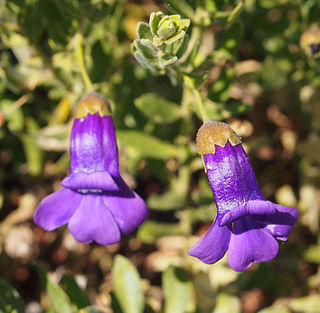
Eremophila macdonnellii, also known as MacDonnell's desert fuchsia, is a flowering plant in the figwort family, Scrophulariaceae and is endemic to Australia. It is a shrub with many tangled branches, which, along with the leaves, are often covered with many, sometimes long hairs. The flowers are deep violet or purple, and the species is widespread in Central Australia.

Verticordia grandis is a large woody shrub that occurs in Southwest Australia. The name grandis, Latin for large, is a reference to its large flowers, leaves, and height. It is well known for its large flowers, which are collected and cultivated, and given the informal name of scarlet featherflower. It was the first species of the family Myrtaceae to have been genetically modified.
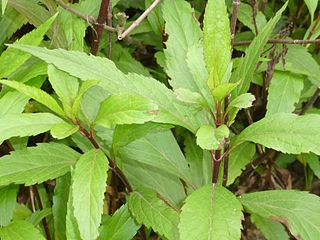
Eupatorium fortunei is a plant species in the family Asteraceae native from Asia where it is rare in the wild but commonly cultivated. The white to reddish colored flowers and herbage smell like lavender when crushed. In China the plants are used to make fragrant oils.
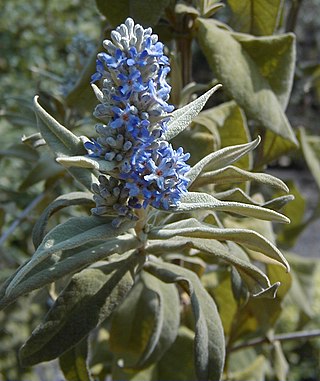
Buddleja salviifolia, common names sage bush and sagewood, is endemic to much of southern and eastern Africa, from Kenya and Angola south, where it grows on rocky hillsides, along forest margins and watercourses. The species was described and named by Lamarck in 1792.

Millettia grandis is a species of plant in the family Fabaceae from South Africa. It is commonly called umzimbeet which is a name derived from the isiZulu name umSimbithwa.
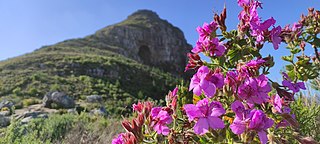
Pelargonium cucullatum is a hairy, upright, branching, perennial shrub, of 1–2 m (3.3–6.6 ft) high, that has been assigned to the cranesbill family. It sprouts new stems from the underground rootstock and becomes woody at its base. It has alternately set, sometimes slightly succulent leaves crowded near the top of the branches, with leaf stalks and flat to hood-shaped leaf blades, with a rounded broad triangular to kidney-shaped outline of about 4–5.5 cm long and 5–9 cm wide, often somewhat incised, the margin with irregular teeth. The white to purplish red, 5-merous, somewhat mirror symmetrical flowers grow in umbel-like clusters, and each contain mostly 7 fertile stamens and 3 infertile staminodes of different length. P. cucullatum has been cultivated as a garden ornamental and house plant since the 17th century. It has been used to breed many modern pelargonium hybrids, notably the Regal pelargoniums. It is called hooded-leaf pelargonium or herba althaea in English and wildemalva in Afrikaans.

Senna italica, the Port Royal senna, Italian senna, or Senegal senna is a legume tree in the genus Senna. It is recognized by many other common names based on the regions it grows in. In India, it is used to produce a powder for treating hair-related diseases which is known as “neutral henna”. Whereas, in some parts of the world, this species is cultivated for the leaves which yield the drug senna, known commonly as Senna glycoside, which in turn is the base for a laxative. Senegal senna is easily distinguishable through its many distinctive features. There are 3 subspecies of this plant based on the size of the inflorescence and the length of the petiole. The subspecies are italica, micrantha, and arachoides. In many regions, this plant is cultivated commercially and medicinally.
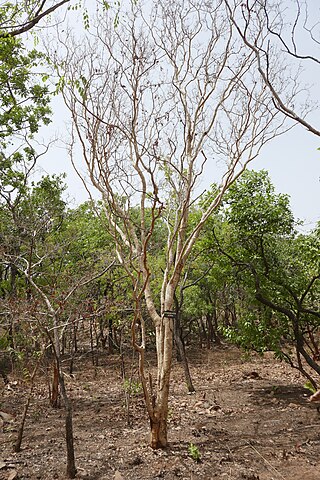
Hymenocardia acida is a plant of the family Phyllanthaceae native to tropical Africa. It is a small tree that grows to 10 m tall. Occurs in the Guinea and Sudanian savannah zones and deciduous woodland, from Senegal eastwards to Ethiopia and southwards reaching Zimbabwe.

Combretum apiculatum is a species of tree in the family Combretaceae known by the common name red bushwillow. It is native to the mesic to semi-arid savanna regions of Africa, southwards of the equator.

Gazania krebsiana is a species of flowering plant in family Asteraceae. It is a low-growing herbaceous perennial native to Southern Africa, ranging from Angola, Zambia, and Mozambique to South Africa. It is one of some 19 species of Gazania that are exclusively African and predominantly South African - only Gazania krebsiana subsp. serrulata (DC.) Roessler ventures northwards from the Transvaal into tropical Africa.

Metarungia pubinervia is an Afrotropical plant species in the acanthus family, which is native to forest understorey in the Afromontane archipelago. It is widespread in eastern Africa, with isolated populations in southern Africa and Nigeria. The species is named for the fine down that covers the main leaf veins (-nervia).

Cadaba aphylla ("Swartstorm") is one of the many species in the genus Cadaba. It is indigenous to southern Africa.

Eremophila flabellata is a flowering plant in the figwort family, Scrophulariaceae and is endemic to Western Australia. It is a small shrub with serrated leaves, broad serrated sepals and pink, purple or mauve flowers.

Eremophila pantonii, commonly known as broombush, is a flowering plant in the figwort family, Scrophulariaceae and is endemic to Western Australia. It is a broom-shaped shrub with narrow leaves which have a hooked tip, and blue or purple, sometimes white flowers in winter and spring.

Pelargonium luridum, locally called variable stork's bill, is a medium high, tuberous herbaceous perennial geophyte, belonging to the Stork's bill family, with white to pink, slightly mirror symmetrical flowers in umbels on long unbranched stalks directly from the ground rosette that consists of few initially ovate, later pinnately incised or linear leaves, with blunt teeth around the margin. The variable stork's bill naturally occurs from South Africa to Angola, southern Congo and Tanzania.

Leucospermum saxosum is an upright evergreen shrub of up to 2 m (6.6 ft) high, that is assigned to the family Proteaceae. It has lance-shaped, leathery leaves and egg-shaped flower heads of about 5 cm (2.0 in) in diameter, with initially yellow-orange flowers, later turning crimson, from which long styles stick out, giving the flower head the appearance of a pincushion. It is called escarpment pincushion in English. It grows on quartzite soils in the mountains on the Zimbabwe-Mozambique border and in eastern Transvaal.

Mairia coriacea is a perennial plant assigned to the family Asteraceae. It has broad, tough and leathery, evergreen leaves. These have a narrowed foot and an entire margin or a few shallow, irregular teeth. They grow in a rosette directly from the rootstock. The plant produces flower heads with one whorl of white to mauve ray florets around many yellow disc florets, with one or few on top of a dark reddish, woolly stalk. Flower heads appear after the overhead vegetation burnt down, often destroying the leaves in the process. It can be found in the southern mountains of South Africa's Western Cape province. It is called leather leaves in English.
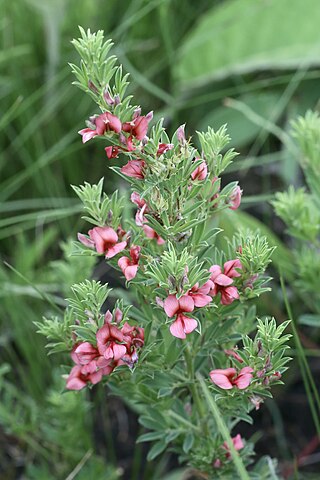
Indigofera hilaris, the red bush indigo or gay indigofera, is a species of leguminous shrublet in the genus Indigofera.
Thesium goetzeanum is a species of plant from Africa, where it grows between South Africa and Kenya.
























